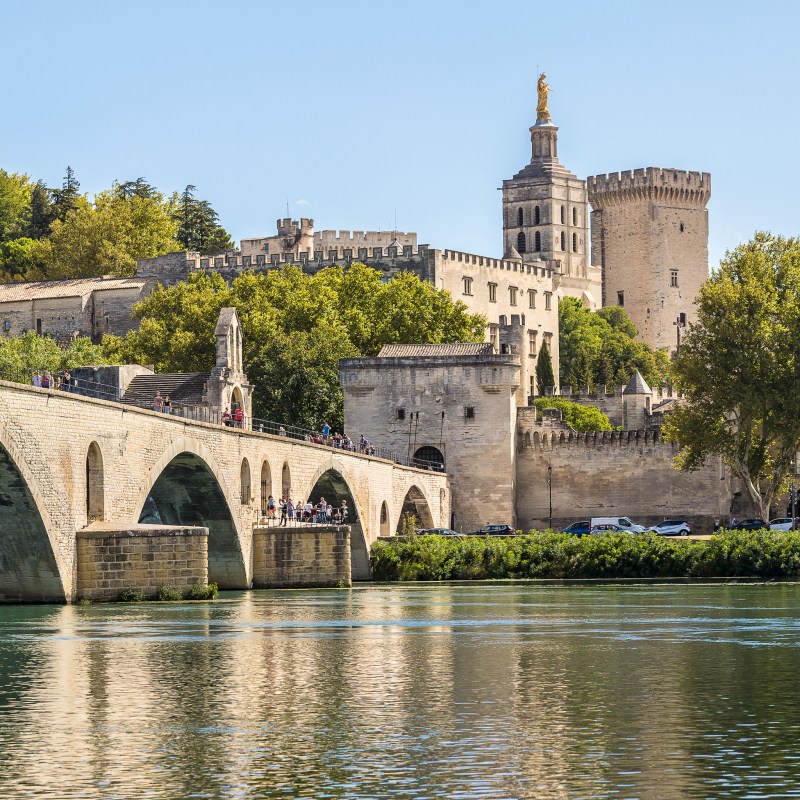
Avignon is the portal city to the iconic Provence region of France. The historically significant city is a two-hour-and-40-minute train ride from Paris’s Gare de Lyon station on the TGV high-speed train. Located on the left bank of the Rhone River, in the 1300s Avignon was replaced by the Vatican as the seat of power for the pope. Much of its architecture, including the 4,300-foot-long ramparts, uses limestone, which was locally mined.
Videos by TravelAwaits

What To See And Do
The Popes’ Palace
The Palais de Papes or Popes’ Palace, is the most important site in Avignon. The massive structure is the largest gothic configuration in Europe, measuring over 49,000 square feet, the equivalent of four gothic churches. It was constructed from 1309 to 1348. It was the seat of Roman Papacy in the same period and was the place where nine successive popes resided. Owned by Joanna I of Naples, the city was still under Papal reign until 1791, during the French Revolution.
Today the Palais de Papes is the main attraction of the old quarter of Avignon and is a UNESCO Heritage site. Visitors can view 25 rooms of the palace, including the pope’s private chambers, the Grand Audience Hall, ceremonial halls such as the Great Clementine Chapel, and Saint Martial and Saint John chapels, with their magnificent murals painted by Italian painter Matteo Giovannetti.

Every year from the second week of August until the second week of October, the palace sponsors a dazzling, 360-degree laser light show on the walls of the inner courtyard.

Pont Saint-Benezet
Another UNESCO Heritage site is Pont Saint-Benezet, a bridge connecting the Rhone River and Avignon. The ancient bridge was constructed between 1177 and 1185, and the history of the bridge is based on a legend. A young shepherd from Villard in the Ardeche region, while tending to his sheep, was said to have received a message from Jesus Christ to build a bridge in order to cross the river. Ridiculed and teased by the townspeople for his nonsensical calling, the shepherd remarkably lifted a humongous block of stone by himself to start the bridge. After receiving full-fledged support from the town for his practical miracle, he formed a Bridge Brotherhood to oversee the construction. Later a chapel bearing his name was built into the bridge.
Collection Lambert
Once a cutting edge Parisian gallerist and art collector, Yvon Lambert now helms his own museum. For almost 50 years, from 1966 to 2014, Lambert showed and helped develop a stable of the top international artists at his gallery in the Marais area of Paris. During that period, Lambert amassed an enormous personal art collection, and after the gallery closed, he purchased two former 18th-century palaces in Avignon, converting them into an art foundation.
The 65,000-square-foot space stores 556 of his contemporary art pieces, which are frequently rotated. Artists in the collection include Jean-Michel Basquiat, Sol LeWitt, Robert Ryman, Nan Goldin, Christian Boltanski, Daniel Buren, Douglas Gordon, and Cy Twombly. Collection Lambert also has temporary exhibitions, a book shop, and a lovely tea salon in the cobblestone courtyard in the spring and summer, plus a year-round indoor cafe.

Avignon Festival
July commences with the most attended event of the year, the annual Avignon Festival. Along the lines of the Spoleto Festival in Italy, the Avignon Festival is one of the most prestigious cultural events in all of Europe. Major artists, performers, dancers, directors, singers, musicians, and dance and theater companies from around the world are invited to stage their works in many languages. Founded by actor Jean Vilar in 1947 with just a single show, today the festival hosts over 1,000 shows in a period of just three weeks. It’s common for people to stay several days or a week to attend the various events that include theater, dance, concerts, and art exhibitions. Those who attend get to ensconce themselves in wall-to-wall culture.
Side Trips From Avignon
Avignon is the gateway to many of the charming villages, sites, and nature of Provence, and you can reserve a rental car at the Avignon TGV station.

Arles
Arles, where Van Gogh painted his legendary landscapes, is a charming village only 20 minutes by car from Avignon that has much to see and do. An almost intact Roman amphitheater from the first century, an antiquities museum, and a group of Roman ruins are just a few of the attractions. The Fondation Vincent Van Gogh is a modern center dedicated to continually preserving and promoting the artist’s work, and the Van Gogh Artists Trail is a walking excursion where you can discover some of the locations Van Gogh painted from.
Arles hosts a citywide photography festival, Les Rencontres d’Arles, which features 60 photo exhibitions in July and August. Every year there’s a theme, and the festival invites a different curator each time. Former fashion designer Christian Lacroix was one of the guest curators.

Glanum And The Thouzon Caves
Just outside of Saint-Remy-de-Provence in the Alpilles mountains is the ancient, Gallic town of Glanum. The village dates back to the second century B.C. and has strong Roman and Greek influences.
The Thouzon Caves, discovered in 1902, are a 60-million-year-old crystallization — a geological miracle. Measuring 670 feet in length, the caves include stalactites, stalagmites, draperies, rimstone dams, and cave pearls; 45-minute tours of the caves, which are in Le Thor, are given daily.
Where To Stay In Avignon
La Mirande
Originally constructed in the 1300s as an annex to the Popes’ Palace that was designated to house religious figures, La Mirande is the premier luxury hotel in Avignon. In the late 1600s, it was reconstructed as a private palace. In 1987, the Stein family purchased the property and spent three years converting it into a deluxe five-star hotel. The sumptuously appointed decor on the main floor and in the guests rooms uses local, Provencal-style antiques, fabrics, linens, and furniture.
La Mirande has a one-star Michelin restaurant, a bar, and afternoon tea service, and cooking classes taught by the best chefs of the Provence area are offered in an old-fashioned French kitchen.
From Tuesday to Saturday, the hotel offers a freshly prepared tasting menu in the same kitchen as the cooking classes, where Severine Sagnet cooks a true farm-to-table dinner for up to 14 people. The price is just over 100 euros per person.
Where To Eat In Avignon
The restaurant at La Mirande is a superb dining experience. If you are in Avignon in the spring and summer months, reserve a table in the lush garden of the hotel, landscaped with fragrant, seasonal flowers, plants, and trees. Chef Florent Pietravalle, who formerly worked for Pierre Gagnaire, a top Parisian chef, creates seasonal, themed menus, which change frequently according to the freshest available ingredients from local farms and food purveyors. He also sources ingredients from the hotel garden and herb patch to add to his dishes.
L’Epicerie is a Provencal-style cafe serving French and Mediterranean delicacies. Outdoor tables with forest green outdoor chairs are placed on the cobblestone streets below the great walls of the Popes’ Palace.
Pro Tips
The train from Paris leaves you off at the Avignon TGV station, which is also the hub for rental cars and buses. However, you must connect to the local train, which takes about seven minutes, to arrive at the center of the city. Your ticket to Avignon includes the price of the local train.
If you travel to Avignon in July, make sure you book your accommodations at least six months in advance because hotels and apartment rentals fill up for the festival. Also, purchase your tickets online for the festival a few months in advance because they sell out quickly.
The cobblestones in the old part of the city are very uneven and tough on the feet, so make sure to wear sneakers or thick, rubber-soled shoes.
Have you rented a car? Here’s how to spend a day in fascinating Carcassonne, France, which is just two and a half hours from Avignon.
